- What Is Python? An Introduction
- What Is The History Of Python?
- Key Features Of The Python Programming Language
- Who Uses Python?
- Basic Characteristics Of Python Programming Syntax
- Why Should You Learn Python?
- Applications Of Python Language
- Advantages And Disadvantages Of Python
- Some Useful Python Tips & Tricks For Efficient Programming
- Python 2 Vs. Python 3: Which Should You Learn?
- Python Libraries
- Conclusion
- Frequently Asked Questions
- It's Python Basics Quiz Time!
- What is Python & its Brief History
- Key Features of Python Programming Language
- Applications of Python Language
- Practical Python Code Examples
- About Python IDLE
- Comparative Features of Python, Java, & C++
- Conclusion
- Frequently Asked Questions
- Take A Quiz To Rehash Python's Features!
- What Is Python IDLE?
- What Is Python Shell & Its Uses?
- Primary Features Of Python IDLE
- How To Use Python IDLE Shell? Setting Up Your Python Environment
- How To Work With Files In Python IDLE?
- How To Execute A File In Python IDLE?
- Improving Workflow In Python IDLE Software
- Debugging In Python IDLE
- Customizing Python IDLE
- Code Examples
- Conclusion
- Frequently Asked Questions (FAQs)
- How Well Do You Know IDLE? Take A Quiz!
- What Is A Variable In Python?
- Creating And Declaring Python Variables
- Rules For Naming Python Variables
- How To Print Python Variables?
- How To Delete A Python Variable?
- Various Methods Of Variables Assignment In Python
- Python Variable Types
- Python Variable Scope
- Concatenating Python Variables
- Object Identity & Object References Of Python Variables
- Reserved Words/ Keywords & Python Variable Names
- Conclusion
- Frequently Asked Questions
- Rehash Python Variables Basics With A Quiz!
- What Is A String In Python?
- Creating String In Python
- How To Create Multiline Python Strings?
- Reassigning Python Strings
- Accessing Characters Of Python Strings
- How To Update Or Delete A Python String?
- Reversing A Python String
- Formatting Python Strings
- Concatenation & Comparison Of Python Strings
- Python String Operators
- Python String Functions
- Escape Sequences In Python Strings
- Conclusion
- Frequently Asked Questions
- Rehash Python Strings Basics With A Quiz!
- What Is Python Namespace?
- Lifetime Of Python Namespace
- Types Of Python Namespace
- The Built-In Namespace In Python
- The Global Namespace In Python
- The Local Namespace In Python
- The Enclosing Namespace In Python
- Variable Scope & Namespace In Python
- Python Namespace Dictionaries
- Changing Variables Out Of Their Scope & Python Namespace
- Best Practices Of Python Namespace
- Conclusion
- Frequently Asked Questions
- Test Your Knowledge Of Python Namespaces!
- What Are Logical Operators In Python?
- The AND Python Logical Operator
- The OR Python Logical Operator
- The NOT Python Logical Operator
- Short-Circuiting Evaluation Of Python Logical Operators
- Precedence of Logical Operators In Python
- How Does Python Calculate Truth Value?
- Final Note On How AND & OR Python Logical Operators Work
- Conclusion
- Frequently Asked Questions
- Python Logical Operators Quiz– Test Your Knowledge!
- What Are Bitwise Operators In Python?
- List Of Python Bitwise Operators
- AND Python Bitwise Operator
- OR Python Bitwise Operator
- NOT Python Bitwise Operator
- XOR Python Bitwise Operator
- Right Shift Python Bitwise Operator
- Left Shift Python Bitwise Operator
- Python Bitwise Operations On Negative Integers
- The Binary Number System
- Application of Python Bitwise Operators
- Python Bitwise Operator Overloading
- Conclusion
- Frequently Asked Questions
- Test Your Knowledge Of Python Bitwise Operators!
- What Is The Print() Function In Python?
- How Does The print() Function Work In Python?
- How To Print Single & Multi-line Strings In Python?
- How To Print Built-in Data Types In Python?
- Print() Function In Python For Values Stored In Variables
- Print() Function In Python With sep Parameter
- Print() Function In Python With end Parameter
- Print() Function In Python With flush Parameter
- Print() Function In Python With file Parameter
- How To Remove Newline From print() Function In Python?
- Use Cases Of The print() Function In Python
- Understanding Print Statement In Python 2 Vs. Python 3
- Conclusion
- Frequently Asked Questions
- Know The print() Function In Python? Take A Quiz!
- Working Of Normal Print() Function
- The New Line Character In Python
- How To Print Without Newline In Python | Using The End Parameter
- How To Print Without Newline In Python 2.x? | Using Comma Operator
- How To Print Without Newline In Python 3.x?
- How To Print Without Newline In Python With Module Sys
- The Star Pattern(*) | How To Print Without Newline & Space In Python
- How To Print A List Without Newline In Python?
- How To Remove New Lines In Python?
- Conclusion
- Frequently Asked Questions
- Think You Can Print Without a Newline in Python? Prove It!
- What Is A Python For Loop?
- How Does Python For Loop Work?
- When & Why To Use Python For Loops?
- Python For Loop Examples
- What Is Rrange() Function In Python?
- Nested For Loops In Python
- Python For Loop With Continue & Break Statements
- Python For Loop With Pass Statement
- Else Statement In Python For Loop
- Conclusion
- Frequently Asked Questions
- Think You Know Python's For Loop? Prove It!
- What Is Python While Loop?
- How Does The Python While Loop Work?
- How To Use Python While Loops For Iterations?
- Control Statements In Python While Loop With Examples
- Python While Loop With Python List
- Infinite Python While Loop in Python
- Python While Loop Multiple Conditions
- Nested Python While Loops
- Conclusion
- Frequently Asked Questions
- Mastered Python While Loop? Let’s Find Out!
- What Are Conditional If-Else Statements In Python?
- Types Of If-Else Statements In Python
- If Statement In Python
- If-Else Statement In Python
- Nested If-Else Statement In Python
- Elif Statement In Python
- Ladder If-Elif-Else Statement In Python
- Short Hand If-Statement In Python
- Short Hand If-Else Statement In Python
- Operators & If-Esle Statement In Python
- Other Statements With If-Else In Python
- Conclusion
- Frequently Asked Questions
- Quick If-Else Statement Quiz– Let’s Go!
- What Is Control Structure In Python?
- Types Of Control Structures In Python
- Sequential Control Structures In Python
- Decision-Making Control Structures In Python
- Repetition Control Structures In Python
- Benefits Of Using Control Structures In Python
- Conclusion
- Frequently Asked Questions
- Control Structures in Python – Are You the Master? Take A Quiz!
- What Are Python Libraries?
- How Do Python Libraries Work?
- Standard Python Libraries (With List)
- Important Python Libraries For Data Science
- Important Python Libraries For Machine & Deep Learning
- Other Important Python Libraries You Must Know
- Working With Third-Party Python Libraries
- Troubleshooting Common Issues For Python Libraries
- Python Libraries In Larger Projects
- Importance Of Python Libraries
- Conclusion
- Frequently Asked Questions
- Quick Quiz On Python Libraries – Let’s Go!
- What Are Python Functions?
- How To Create/ Define Functions In Python?
- How To Call A Python Function?
- Types Of Python Functions Based On Parameters & Return Statement
- Rules & Best Practices For Naming Python Functions
- Basic Types of Python Functions
- The Return Statement In Python Functions
- Types Of Arguments In Python Functions
- Docstring In Python Functions
- Passing Parameters In Python Functions
- Python Function Variables | Scope & Lifetime
- Advantages Of Using Python Functions
- Recursive Python Function
- Anonymous/ Lambda Function In Python
- Nested Functions In Python
- Conclusion
- Frequently Asked Questions
- Python Functions – Test Your Knowledge With A Quiz!
- What Are Python Built-In Functions?
- Mathematical Python Built-In Functions
- Python Built-In Functions For Strings
- Input/ Output Built-In Functions In Python
- List & Tuple Python Built-In Functions
- File Handling Python Built-In Functions
- Python Built-In Functions For Dictionary
- Type Conversion Python Built-In Functions
- Basic Python Built-In Functions
- List Of Python Built-In Functions (Alphabetical)
- Conclusion
- Frequently Asked Questions
- Think You Know Python Built-in Functions? Prove It!
- What Is A round() Function In Python?
- How Does Python round() Function Work?
- Python round() Function If The Second Parameter Is Missing
- Python round() Function If The Second Parameter Is Present
- Python round() Function With Negative Integers
- Python round() Function With Math Library
- Python round() Function With Numpy Module
- Round Up And Round Down Numbers In Python
- Truncation Vs Rounding In Python
- Practical Applications Of Python round() Function
- Conclusion
- Frequently Asked Questions
- Revisit Python’s round() Function – Take The Quiz!
- What Is Python pow() Function?
- Python pow() Function Example
- Python pow() Function With Modulus (Three Parameters)
- Python pow() Function With Complex Numbers
- Python pow() Function With Floating-Point Arguments And Modulus
- Python pow() Function Implementation Cases
- Difference Between Inbuilt-pow() And math.pow() Function
- Conclusion
- Frequently Asked Questions
- Test Your Knowledge Of Python’s pow() Function!
- Python max() Function With Objects
- Examples Of Python max() Function With Objects
- Python max() Function With Iterable
- Examples Of Python max() Function With Iterables
- Potential Errors With The Python max() Function
- Python max() Function Vs. Python min() Functions
- Conclusion
- Frequently Asked Questions
- Think You Know Python max() Function? Take A Quiz!
- What Are Strings In Python?
- What Are Python String Methods?
- List Of Python String Methods For Manipulating Case
- List Of Python String Methods For Searching & Finding
- List Of Python String Methods For Modifying & Transforming
- List Of Python String Methods For Checking Conditions
- List Of Python String Methods For Encoding & Decoding
- List Of Python String Methods For Stripping & Trimming
- List Of Python String Methods For Formatting
- Miscellaneous Python String Methods
- List Of Other Python String Operations
- Conclusion
- Frequently Asked Questions
- Mastered Python String Methods? Take A Quiz!
- What Is Python String?
- The Need For Python String Replacement
- The Python String replace() Method
- Multiple Replacements With Python String.replace() Method
- Replace A Character In String Using For Loop In Python
- Python String Replacement Using Slicing Method
- Replace A Character At a Given Position In Python String
- Replace Multiple Substrings With The Same String In Python
- Python String Replacement Using Regex Pattern
- Python String Replacement Using List Comprehension & Join() Method
- Python String Replacement Using Callback With re.sub() Method
- Python String Replacement With re.subn() Method
- Conclusion
- Frequently Asked Questions
- Know How To Replace Python Strings? Prove It!
- What Is String Slicing In Python?
- How Indexing & String Slicing Works In Python
- Extracting All Characters Using String Slicing In Python
- Extracting Characters Before & After Specific Position Using String Slicing In Python
- Extracting Characters Between Two Intervals Using String Slicing In Python
- Extracting Characters At Specific Intervals (Step) Using String Slicing In Python
- Negative Indexing & String Slicing In Python
- Handling Out-of-Bounds Indices In String Slicing In Python
- The slice() Method For String Slicing In Python
- Common Pitfalls Of String Slicing In Python
- Real-World Applications Of String Slicing
- Conclusion
- Frequently Asked Questions
- Quick Python String Slicing Quiz– Let’s Go!
- Introduction To Python List
- How To Create A Python List?
- How To Access Elements Of Python List?
- Accessing Multiple Elements From A Python List (Slicing)
- Access List Elements From Nested Python Lists
- How To Change Elements In Python Lists?
- How To Add Elements To Python Lists?
- Delete/ Remove Elements From Python Lists
- How To Create Copies Of Python Lists?
- Repeating Python Lists
- Ways To Iterate Over Python Lists
- How To Reverse A Python List?
- How To Sort Items Of Python Lists?
- Built-in Functions For Operations On Python Lists
- Conclusion
- Frequently Asked Questions
- Revisit Python Lists Basics With A Quick Quiz!
- What Is List Comprehension In Python?
- Incorporating Conditional Statements With List Comprehension In Python
- List Comprehension In Python With range()
- Filtering Lists Effectively With List Comprehension In Python
- Nested Loops With List Comprehension In Python
- Flattening Nested Lists With List Comprehension In Python
- Handling Exceptions In List Comprehension In Python
- Common Use Cases For List Comprehensions
- Advantages & Disadvantages Of List Comprehension In Python
- Best Practices For Using List Comprehension In Python
- Performance Considerations For List Comprehension In Python
- For Loops & List Comprehension In Python: A Comparison
- Difference Between Generator Expression & List Comprehension In Python
- Conclusion
- Frequently Asked Questions
- Rehash Python List Comprehension Basics With A Quiz!
- What Is A List In Python?
- How To Find Length Of List In Python?
- For Loop To Get Python List Length (Naive Approach)
- The len() Function To Get Length Of List In Python
- The length_hint() Function To Find Length Of List In Python
- The sum() Function To Find The Length Of List In Python
- The enumerate() Function To Find Python List Length
- The Counter Class From collections To Find Python List Length
- The List Comprehension To Find Python List Length
- Find The Length Of List In Python Using Recursion
- Comparison Between Ways To Find Python List Length
- Conclusion
- Frequently Asked Questions
- Know How To Get Python List Length? Prove it!
- List of Methods To Reverse A Python List
- Python Reverse List Using reverse() Method
- Python Reverse List Using the Slice Operator ([::-1])
- Python Reverse List By Swapping Elements
- Python Reverse List Using The reversed() Function
- Python Reverse List Using A for Loop
- Python Reverse List Using While Loop
- Python Reverse List Using List Comprehension
- Python Reverse List Using List Indexing
- Python Reverse List Using The range() Function
- Python Reverse List Using NumPy
- Comparison Of Ways To Reverse A Python List
- Conclusion
- Frequently Asked Questions
- Time To Test Your Python List Reversal Skills!
- What Is Indexing In Python?
- The Python List index() Function
- How To Use Python List index() To Find Index Of A List Element
- The Python List index() Method With Single Parameter (Start)
- The Python List index() Method With Start & Stop Parameters
- What Happens When We Use Python List index() For An Element That Doesn't Exist
- Python List index() With Nested Lists
- Fixing IndexError Using The Python List index() Method
- Python List index() With Enumerate()
- Real-world Examples Of Python List index() Method
- Difference Between find() And index() Method In Python
- Conclusion
- Frequently Asked Questions
- Think You Know Python List Indexing? Take A Quiz!
- How To Remove Elements From List In Python?
- The remove() Method To Remove Element From Python List
- The pop() Method To Remove Element From List In Python
- The del Keyword To Remove Element From List In Python
- The clear() Method To Remove Elements From Python List
- List Comprehensions To Conditionally Remove Element From List In Python
- Key Considerations For Removing Elements From Python Lists
- Why We Need to Remove Elements From Python List
- Performance Comparison Of Methods To Remove Element From List In Python
- Conclusion
- Frequently Asked Questions
- Quiz– Prove You Know How To Remove Item From Python Lists!
- How To Remove Duplicates From A List In Python?
- The set() Function To Remove Duplicates From Python List
- Remove Duplicates From Python List Using For Loop
- Using List Comprehension Remove Duplicates From Python List
- Remove Duplicates From Python List Using enumerate() With List Comprehension
- Dictionary & fromkeys() Method To Remove Duplicates From Python List
- Remove Duplicates From Python List Using in, not in Operators
- Remove Duplicates From Python List Using collections.OrderedDict.fromkeys()
- Remove Duplicates From Python List Using Counter with freq.dist() Method
- The del Keyword Remove Duplicates From Python List
- Remove Duplicates From Python List Using DataFrame
- Remove Duplicates From Python List Using pd.unique and np.unipue
- Remove Duplicates From Python List Using reduce() function
- Comparative Analysis Of Ways To Remove Duplicates From Python List
- Conclusion
- Frequently Asked Questions
- Think You Know How to Remove Duplicates? Take A Quiz!
- What Is Python List & How To Access Elements?
- What Is IndexError: List Index Out Of Range & Its Causes In Python?
- Understanding Indexing Behavior In Python Lists
- How to Prevent/ Fix IndexError: List Index Out Of Range In Python
- Handling IndexError Gracefully Using Try-Except
- Debugging Tips For IndexError: List Index Out Of Range Python
- Conclusion
- Frequently Asked Questions
- Avoiding ‘List Index Out of Range’ Errors? Take A Quiz!
- What Is the Python sort() List Method?
- Sorting In Ascending Order Using The Python sort() List Method
- How To Sort Items In Descending Order Using Python sort() List Method
- Custom Sorting Using The Key Parameter Of Python sort() List Method
- Examples Of Python sort() List Method
- What Is The sorted() List Method In Python
- Differences Between sorted() And sort() List Methods In Python
- When To Use sorted() & When To Use sort() List Method In Python
- Conclusion
- Frequently Asked Questions
- Take A Quick Python's sort() Quiz!
- What Is A List In Python?
- What Is A String In Python?
- Why Convert Python List To String?
- How To Convert List To String In Python?
- The join() Method To Convert Python List To String
- Convert Python List To String Through Iteration
- Convert Python List To String With List Comprehension
- The map() Function To Convert Python List To String
- Convert Python List to String Using format() Function
- Convert Python List To String Using Recursion
- Enumeration Function To Convert Python List To String
- Convert Python List To String Using Operator Module
- Python Program To Convert String To List
- Conclusion
- Frequently Asked Questions
- Convert Lists To Strings Like A Pro! Take A Quiz
- What Is Inheritance In Python?
- Python Inheritance Syntax
- Parent Class In Python Inheritance
- Child Class In Python Inheritance
- The __init__() Method In Python Inheritance
- The super() Function In Python Inheritance
- Method Overriding In Python Inheritance
- Types Of Inheritance In Python
- Special Functions In Python Inheritance
- Advantages & Disadvantages Of Inheritance In Python
- Common Use Cases For Inheritance In Python
- Best Practices for Implementing Inheritance in Python
- Avoiding Common Pitfalls in Python Inheritance
- Conclusion
- Frequently Asked Questions
- 💡 Python Inheritance Quiz – Are You Ready?
- What Is The Python List append() Method?
- Adding Elements To A Python List Using append()
- Populate A Python List Using append()
- Adding Different Data Types To Python List Using append()
- Adding A List To Python List Using append()
- Nested Lists With Python List append() Method
- Practical Use Cases Of Python List append() Method
- How append() Method Affects List Performance
- Avoiding Common Mistakes When Using Python List append()
- Comparing extend() With append() Python List Method
- Conclusion
- Frequently Asked Questions
- 🧠 Think You Know Python List append()? Take A Quiz!
- What Is A Linked List In Python?
- Types Of Linked Lists In Python
- How To Create A Linked List In Python
- How To Traverse A Linked List In Python & Retrieve Elements
- Inserting Elements In A Linked List In Python
- Deleting Elements From A Linked List In Python
- Update A Node Of Linked List In Python
- Reversing A Linked List In Python
- Calculating Length Of A Linked List In Python
- Comparing Arrays And Linked Lists In Python
- Advantages & Disadvantages Of Linked List In Python
- When To Use Linked Lists Over Other Data Structures
- Practical Applications Of Linked Lists In Python
- Conclusion
- Frequently Asked Questions
- 🔗 Linked List Logic: Can You Ace This Quiz?
- What Is Extend In Python?
- Extend In Python With List
- Extend In Python With String
- Extend In Python With Tuple
- Extend In Python With Set
- Extend In Python With Dictionary
- Other Methods To Extend A List In Python
- Difference Between append() and extend() In Python
- Conclusion
- Frequently Asked Questions
- Think You Know extend() In Python? Prove It!
- What Is Recursion In Python?
- Key Components Of Recursive Functions In Python
- Implementing Recursion In Python
- Recursion Vs. Iteration In Python
- Tail Recursion In Python
- Infinite Recursion In Python
- Advantages Of Recursion In Python
- Disadvantages Of Recursion In Python
- Best Practices For Using Recursion In Python
- Conclusion
- Frequently Asked Questions
- Recursive Thinking In Python: Test Your Skills!
- What Is Type Conversion In Python?
- Types Of Type Conversion In Python
- Implicit Type Conversion In Python
- Explicit Type Conversion In Python
- Functions Used For Explicit Data Type Conversion In Python
- Important Type Conversion Tips In Python
- Benefits Of Type Conversion In Python
- Conclusion
- Frequently Asked Questions
- Think You Know Type Conversion? Take A Quiz!
- What Is Scope In Python?
- Local Scope In Python
- Global Scope In Python
- Nonlocal (Enclosing) Scope In Python
- Built-In Scope In Python
- The LEGB Rule For Python Scope
- Python Scope And Variable Lifetime
- Best Practices For Managing Python Scope
- Conclusion
- Frequently Asked Questions
- Think You Know Python Scope? Test Yourself!
- Understanding The Continue Statement In Python
- How Does Continue Statement Work In Python?
- Python Continue Statement With For Loops
- Python Continue Statement With While Loops
- Python Continue Statement With Nested Loops
- Python Continue With If-Else Statement
- Difference Between Pass and Continue Statement In Python
- Practical Applications Of Continue Statement In Python
- Conclusion
- Frequently Asked Questions
- Python 'continue' Statement Quiz: Can You Ace It?
- What Are Control Statements In Python?
- Types Of Control Statements In Python
- Conditional Control Statements In Python
- Loop Control Statements In Python
- Control Flow Altering Statements In Python
- Exception Handling Control Statements In Python
- Conclusion
- Frequently Asked Questions
- Mastering Control Statements In Python – Take the Quiz!
- Difference Between Mutable And Immutable Data Types in Python
- What Is Mutable Data Type In Python?
- Types Of Mutable Data Types In Python
- What Are Immutable Data Types In Python?
- Types Of Immutable Data Types In Python
- Key Similarities Between Mutable And Immutable Data Types In Python
- When To Use Mutable Vs Immutable In Python?
- Conclusion
- Frequently Asked Questions
- Quiz Time: Mutable vs. Immutable In Python!
- What Is A List?
- What Is A Tuple?
- Difference Between List And Tuple In Python (Comparison Table)
- Syntax Difference Between List And Tuple In Python
- Mutability Difference Between List And Tuple In Python
- Other Difference Between List And Tuple In Python
- List Vs. Tuple In Python | Methods
- When To Use Tuples Over Lists?
- Key Similarities Between Tuples And Lists In Python
- Conclusion
- Frequently Asked Questions
- 🧐 Lists vs. Tuples Quiz: Test Your Python Knowledge!
- Introduction to Python
- Downloading & Installing Python, IDLE, Tkinter, NumPy & PyGame
- Creating A New Python Project
- How To Write Python Hello World Program In Python?
- Way To Write The Hello, World! Program In Python
- The Hello, World! Program In Python Using Class
- The Hello, World! Program In Python Using Function
- Print Hello World 5 Times Using A For Loop
- Conclusion
- Frequently Asked Questions
- 👋 Python's 'Hello, World!'—How Well Do You Know It?
- Algorithm Of Python Program To Add To Numbers
- Standard Program To Add Two Numbers In Python
- Python Program To Add Two Numbers With User-defined Input
- The add() Method In Python Program To Add Two Numbers
- Python Program To Add Two Numbers Using Lambda
- Python Program To Add Two Numbers Using Function
- Python Program To Add Two Numbers Using Recursion
- Python Program To Add Two Numbers Using Class
- How To Add Multiple Numbers In Python?
- Add Multiple Numbers In Python With User Input
- Time Complexities Of Python Programs To Add Two Numbers
- Conclusion
- Frequently Asked Questions
- 💡 Quiz Time: Python Addition Basics!
- Swapping in Python
- Swapping Two Variables Using A Temporary Variable
- Swapping Two Variables Using The Comma Operator In Python
- Swapping Two Variables Using The Arithmetic Operators (+,-)
- Swapping Two Variables Using The Arithmetic Operators (*,/)
- Swapping Two Variables Using The XOR(^) Operator
- Swapping Two Variables Using Bitwise Addition and Subtraction
- Swap Variables In A List
- Conclusion
- Frequently Asked Questions (FAQs)
- Quiz To Test Your Variable Swapping Knowledge
- What Is A Quadratic Equation? How To Solve It?
- How To Write A Python Program To Solve Quadratic Equations?
- Python Program To Solve Quadratic Equations Directly Using The Formula
- Python Program To Solve Quadratic Equations Using The Complex Math Module
- Python Program To Solve Quadratic Equations Using Functions
- Python Program To Solve Quadratic Equations & Find Number Of Solutions
- Python Program To Plot Quadratic Functions
- Conclusion
- Frequently Asked Questions
- Quadratic Equations In Python Quiz: Test Your Knowledge!
- What Is Decimal Number System?
- What Is Binary Number System?
- What Is Octal Number System?
- What Is Hexadecimal Number System?
- Python Program to Convert Decimal to Binary, Octal, And Hexadecimal Using Built-In Function
- Python Program To Convert Decimal To Binary Using Recursion
- Python Program To Convert Decimal To Octal Using Recursion
- Python Program To Convert Decimal To Hexadecimal Using Recursion
- Python Program To Convert Decimal To Binary Using While Loop
- Python Program To Convert Decimal To Octal Using While Loop
- Python Program To Convert Decimal To Hexadecimal Using While Loop
- Convert Decimal To Binary, Octal, And Hexadecimal Using String Formatting
- Python Program To Convert Binary, Octal, And Hexadecimal String To A Number
- Complexity Comparison Of Python Programs To Convert Decimal To Binary, Octal, And Hexadecimal
- Conclusion
- Frequently Asked Questions
- 💡 Decimal To Binary, Octal & Hex: Quiz Time!
- What Is A Square Root?
- Python Program To Find The Square Root Of A Number
- The pow() Function In Python Program To Find The Square Root Of Given Number
- Python Program To Find Square Root Using The sqrt() Function
- The cmath Module & Python Program To Find The Square Root Of A Number
- Python Program To Find Square Root Using The Exponent Operator (**)
- Python Program To Find Square Root With A User-Defined Function
- Python Program To Find Square Root Using A Class
- Python Program To Find Square Root Using Binary Search
- Python Program To Find Square Root Using NumPy Module
- Conclusion
- Frequently Asked Questions
- 🤓 Think You Know Square Roots In Python? Take A Quiz!
- Understanding the Logic Behind the Conversion of Kilometers to Miles
- Steps To Write Python Program To Convert Kilometers To Miles
- Python Program To Convert Kilometer To Miles Without Function
- Python Program To Convert Kilometer To Miles Using Function
- Python Program to Convert Kilometer To Miles Using Class
- Tips For Writing Python Program To Convert Kilometer To Miles
- Conclusion
- Frequently Asked Questions
- 🧐 Mastered Kilometer To Mile Conversion? Prove It!
- Why Build A Calculator Program In Python?
- Prerequisites To Writing A Calculator Program In Python
- Approach For Writing A Calculator Program In Python
- Simple Calculator Program In Python
- Calculator Program In Python Using Functions
- Creating GUI Calculator Program In Python Using Tkinter
- Conclusion
- Frequently Asked Questions
- 🧮 Calculator Program In Python Quiz!
- The Calendar Module In Python
- Prerequisites For Writing A Calendar Program In Python
- How To Write And Print A Calendar Program In Python
- Calendar Program In Python To Display A Month
- Calendar Program In Python To Display A Year
- Conclusion
- Frequently Asked Questions
- Calendar Program In Python – Quiz Time!
- What Is The Fibonacci Series?
- Pseudocode Code For Fibonacci Series Program In Python
- Generating Fibonacci Series In Python Using Naive Approach (While Loop)
- Fibonacci Series Program In Python Using The Direct Formula
- How To Generate Fibonacci Series In Python Using Recursion?
- Generating Fibonacci Series In Python With Dynamic Programming
- Fibonacci Series Program In Python Using For Loop
- Generating Fibonacci Series In Python Using If-Else Statement
- Generating Fibonacci Series In Python Using Arrays
- Generating Fibonacci Series In Python Using Cache
- Generating Fibonacci Series In Python Using Backtracking
- Fibonacci Series In Python Using Power Of Matix
- Complexity Analysis For Fibonacci Series Programs In Python
- Applications Of Fibonacci Series In Python & Programming
- Conclusion
- Frequently Asked Questions
- 🤔 Think You Know Fibonacci Series? Take A Quiz!
- Different Ways To Write Random Number Generator Python Programs
- Random Module To Write Random Number Generator Python Programs
- The Numpy Module To Write Random Number Generator Python Programs
- The Secrets Module To Write Random Number Generator Python Programs
- Understanding Randomness and Pseudo-Randomness In Python
- Common Issues and Solutions in Random Number Generation
- Applications of Random Number Generator Python
- Conclusion
- Frequently Asked Questions
- Think You Know Python's Random Module? Prove It!
- What Is A Factorial?
- Algorithm Of Program To Find Factorial Of A Number In Python
- Pseudocode For Factorial Program in Python
- Factorial Program In Python Using For Loop
- Factorial Program In Python Using Recursion
- Factorial Program In Python Using While Loop
- Factorial Program In Python Using If-Else Statement
- The math Module | Factorial Program In Python Using Built-In Factorial() Function
- Python Program to Find Factorial of a Number Using Ternary Operator(One Line Solution)
- Python Program For Factorial Using Prime Factorization Method
- NumPy Module | Factorial Program In Python Using numpy.prod() Function
- Complexity Analysis Of Factorial Programs In Python
- Conclusion
- Frequently Asked Questions
- Think You Know Factorials In Python? Take A Quiz!
- What Is Palindrome In Python?
- Check Palindrome In Python Using While Loop (Iterative Approach)
- Check Palindrome In Python Using For Loop And Character Matching
- Check Palindrome In Python Using The Reverse And Compare Method (Python Slicing)
- Check Palindrome In Python Using The In-built reversed() And join() Methods
- Check Palindrome In Python Using Recursion Method
- Check Palindrome In Python Using Flag
- Check Palindrome In Python Using One Extra Variable
- Check Palindrome In Python By Building Reverse, One Character At A Time
- Complexity Analysis For Palindrome Programs In Python
- Real-World Applications Of Palindrome In Python
- Conclusion
- Frequently Asked Questions
- Think You Know Palindromes? Take A Quiz!
- Best Python Books For Beginners
- Best Python Books For Intermediate Level
- Best Python Books For Experts
- Best Python Books To Learn Algorithms
- Audiobooks of Python
- Best Books To Learn Python And Code Like A Pro
- To Learn Python Libraries
- Books To Provide Extra Edge In Python
- Python Project Ideas - Reference
- Quiz To Rehash Your Knowledge Of Python Books!
- What Are Classes In Python?
- How To Create/Define Classes In Python?
- What Is An Object In Python?
- How To Create Objects In Python Classes?
- Modifying & Deleting Objects In Python Classes
- The __init__() Method In Python Classes
- The __str__() Method In Python Classes
- The Role Of self Parameter In Python Classes
- Different Methods In Classes In Python
- Instance Attributes vs. Class Attributes In Python Classes
- Object-Oriented Programming (OOP) Concepts In Python
- Practical Examples Of Classes & Objects In Python
- Why & When To Use Classes In Python Programs?
- Common Pitfalls Of Using Classes In Python Programs
- Conclusion
- Frequently Asked Questions
- What Is A String & How Python Handles It?
- Concatenation For String Manipulation In Python
- String Comparison In Python
- Slicing For String Manipulation in Python
- String Replacement Manipulation In Python
- Reversion String Manipulation In Python
- String Formatting In Python
- The Length Of A String In Python
- Conversion Of String In Python
- String Methods For String Manipulation In Python
- Conclusion
- Frequently Asked Questions
- How To Convert String To List In Python? (List Of Methods)
- Using split() To Convert A String To A List In Python
- Using list() To Convert A String To A List In Python
- Using List Comprehension To Convert A String To A List
- Using map() To Convert A String To A List In Python
- Using ast.literal_eval() To Convert A String To A List In Python
- Using Regular Expressions To Convert A String To A List
- Using JSON Parsing To Convert A String To A List In Python
- Using String Slicing To Convert A String To A List In Python
- Using enumerate() to Convert a String to a List In Python
- Handling Edge Cases When Converting A String To A List In Python
- Performance Comparison Of Ways To Convert String To List In Python
- Conclusion
- Frequently Asked Questions
- What Is A Python List?
- What Are Python List Functions? (Table)
- The list() Function In Python
- The append() Python List Function
- The copy() Python List Function
- The count() Python List Function
- The clear() And remove() Python List Functions
- The extend() Python List Function
- The index() Python List Function
- The insert() Python List Function
- The pop() Python List Function
- The reverse() Python List Function
- The sort() Python List Function
- The len() Python List Function
- Conclusion
- Frequently Asked Questions
- What Are Identifiers In Python?
- Rules For Naming Identifiers In Python
- Valid & Invalid Identifiers In Python
- How To Test Validity Of Identifiers In Python
- Best Practices For Using Identifiers In Python
- What Are Keywords In Python?
- Difference Between Keywords & Identifiers In Python
- Conclusion
- Frequently Asked Questions
- What Is Python’s split() String Function?
- How Does Python's split() String Method Work?
- Using Python's split() String Method With & Without maxsplit
- Parsing A String Using split() Function In Python
- Examples Of Using Python's split() String Method (10 Use Cases)
- Conclusion
- Frequently Asked Questions
- What Are Keywords In Python?
- List Of Python Keywords
- Types/Categories Of Python Keywords
- Control Flow Keywords In Python
- Function & Class Definition Keywords
- Exception Handling Keywords In Python
- Variable Scope/Handling Python Keywords
- Operator Keywords In Python (Logical & Membership)
- Module & Import Management Keywords
- Asynchronous Programming Keywords In Python
- Context Management Keywords In Python
- Boolean & Null Values In Python
- Pattern Matching/Soft Python Keywords
- Type Alias Definitions Keyword In Python
- Conclusion
- Frequently Asked Questions
- What Are Arguments In Python?
- Types Of Arguments In Python
- What Are Keyword Arguments In Python?
- Why Use Keyword Arguments In Python?
- Where To Use Keyword Arguments In Python
- Arbitrary Arguments Vs. Keyword Arguments
- Conclusion
- Frequently Asked Questions
- What Is Method Overriding In Python?
- Features/Rules Of Method Overriding In Python
- Implementation Of Method Overriding In Python With Examples
- Method Overriding In Python With Multiple Inheritance
- Method Overriding In Python With Multilevel Inheritance
- Method Overloading In Python
- Common Mistakes In Method Overriding In Python
- Conclusion
- Frequently Asked Questions
Python Variables | A Comprehensive Guide With Code Examples
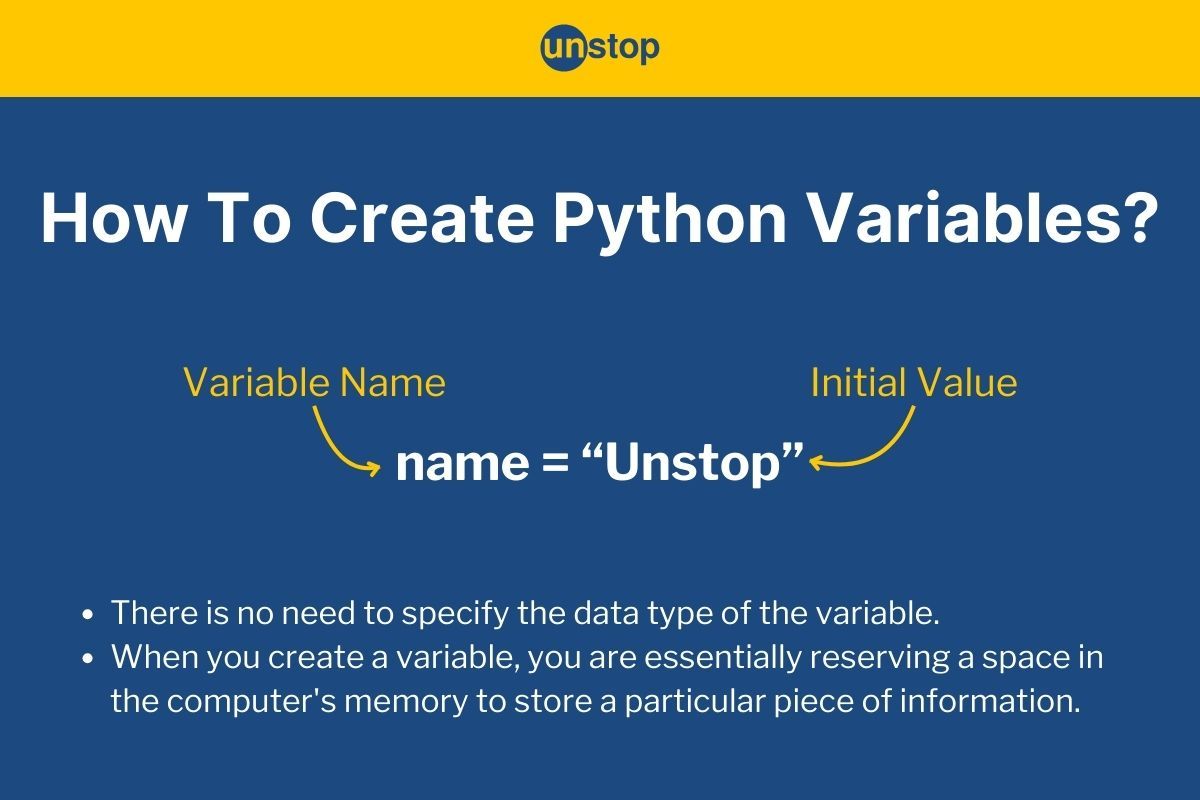
Embarking on the journey of Python programming opens the door to a world of possibilities, and at its core lies the concept of variables. These unassuming entities are the building blocks of code, the vessels that store and manipulate data. In this article, we delve into the fundamentals of Python variables, understanding how they work, exploring their dynamic nature, and gaining insights into best practices. Whether you're a novice coder or a seasoned developer, grasping the essence of Python variables lays a solid foundation for unlocking the language's potential.
What Is A Variable In Python?
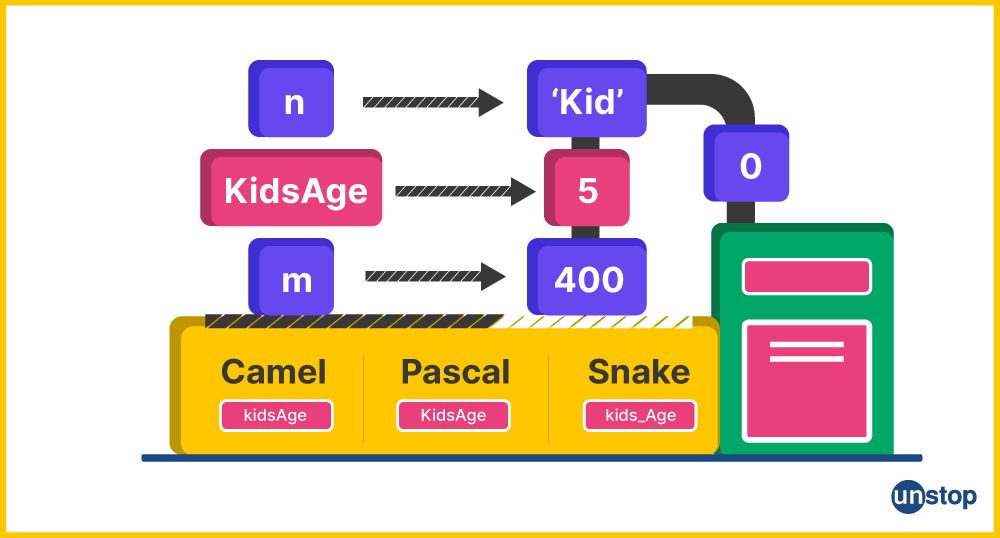
In Python, a variable is a symbolic name or identifier that represents a memory location containing data, such as a numeric value, a string, or any other type of information. Unlike some other programming languages, Python is a dynamically typed language, meaning you don't need to explicitly declare the type of a variable. Instead, the type is inferred based on the value assigned to it.
- Variables play a crucial role in programming by allowing developers to store and manipulate data in their programs.
- When you create a variable, you are essentially reserving a space in the computer's memory to store a particular piece of information.
- The name given to the variable serves as a reference to access and modify this stored data.
- Variables can be reassigned to different values during the execution of a program, making Python a flexible and dynamic language.
For example, you might use a variable named count to store the number of items in a list or an integer object/ variable named age to represent a person's age. The ability to use variables makes it easier to write code that is both readable and adaptable to different situations.
Creating And Declaring Python Variables
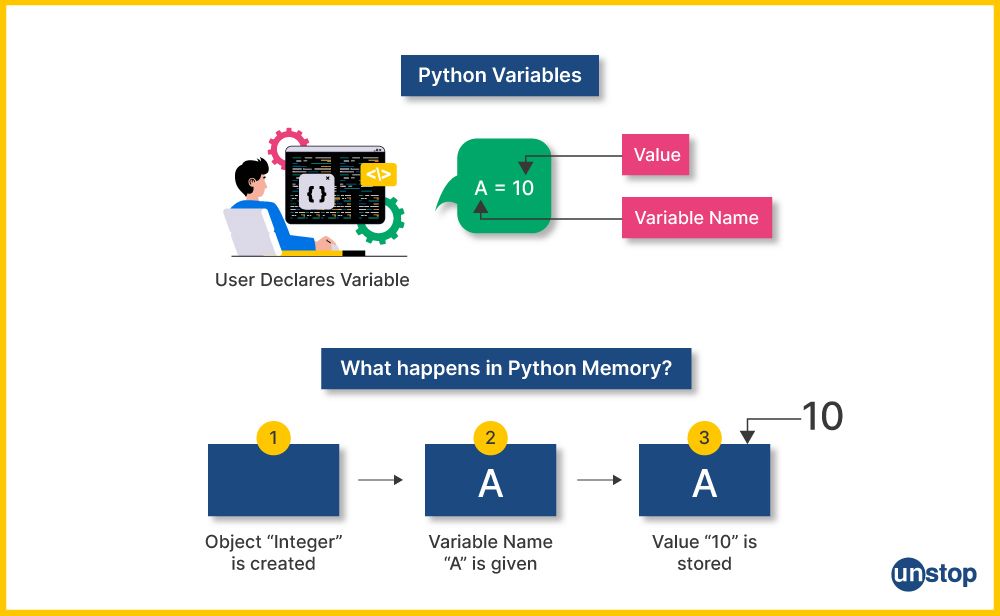
A Python variable self-assigns the best possible datatype as you assign a value to it. You can simply type the name of the variable, say x equals 3, and it will assign a suitable data type (int in this case) to it. In case you want to change the variable type yourself, it's discussed later in the article.
Let’s take a look at an example of how to declare a variable in Python.
Code Example:
CODE SNIPPET IS HEREI0NyZWF0aW5nIGEgdmFyaWFibGUgeA0KeD0zDQoNCiNQcmludGluZyB0aGUgdmFsdWUgb2YgeA0KcHJpbnQoeCk=
Output:
3
Explanation:
- We begin by assigning the variable x a value of 3. Note that we are not using any data type keywords since there is no need to do so in Python.
- Then, we use the print() function to display the value of x, which also automatically determines the datatype to print.
You can even assign other values, like words or decimal values, to a Python variable in a similar way.
Code Example:
CODE SNIPPET IS HEREIyBEZWNsYXJpbmcgdmFyaWFibGVzIHdpdGggYXNzaWduZWQgdmFsdWVzDQp3b3JkID0gIlVuc3RvcCINCmRlY2ltYWwgPSAzLjE0MTUNCg0KIyBQcmludGluZyB0aGUgdmFsdWVzIG9mIHRoZSB2YXJpYWJsZXMNCnByaW50KHdvcmQpDQpwcmludChkZWNpbWFsKQ==
Output:
Unstop
3.1415
Explanation:
- We begin the sample Python code above by declaring and initializing two variables, i.e., word with the value Unstop and decimal with the value 3.1415.
- We know Python automatically adjusts the variable datatype according to need. So, the data type of the variable word would be a string, and that of decimal would be floating-point/ float.
- Next, we use the print() statement to display the values of these variables. The print function can print any value of any built-in datatype just by passing the variable as a parameter.
Rules For Naming Python Variables
While the Python language automatically determines the data types of variables, there are a few rules we must adhere to when naming them. This is essential to creating valid variables. The rules are as follows:
- Valid Sequences of Characters: Variable names can consist of letters (both uppercase and lowercase), digits, and the underscore character (_). However, they cannot start with a digit or any special characters.
- Case-Sensitivity: Python is case-sensitive, so myVariable and myvariable would be considered different variables.
- Reserved Words: Avoid using Python reserved words (keywords) as variable names. Examples of reserved words include if, else, for, while, class, etc.
- No Spaces: Variable names cannot contain spaces. However, you can use underscores or camel case for readability (e.g., my_variable or myVariable). Camel case is where instead of using spaces, you capitalize every next word after the first one.
- Avoid Built-in Names: Avoid using names that are already used for built-in functions or objects in Python (e.g., print, str, list). Overriding built-in names can lead to unexpected behavior.
- Meaningful and Descriptive: Choose variable names that are meaningful and descriptive of the variable's purpose. This improves code readability, especially in complex codes.
- Snake Case for Variables: It's a common convention in Python to use snake case for variable names (e.g., my_variable). This means words are lowercase and separated by underscores.
- Camel Case for Classes: For class names, use the Pascal case, which is similar to the camel case. But the difference is that in the former, each word, including the first, is capitalized, i.e., starts with capital letters (e.g., MyClass).
- Length Limitation: While there's no strict limit, it's good practice to keep variable names reasonably short and descriptive. Long, descriptive names are preferred over short and cryptic ones.
How To Print Python Variables?
You can print the value of a Python variable by just using the print function. In Python, you do not need to specify any parameters in the print function (such as format specifiers or escape sequences). This is because the function automatically identifies the datatype and then prints it similarly to the assignment.
- You can also print any type of data type, including pictures, which, using the print function, gives a matrix.
- However, you can use custom print functions from relevant libraries to do it however you want.
- Also note that in Python, the print function automatically prints on the next line.
- You can also use the display function in case you are working on a jupyter notebook.
Let's take a look at an example where we print the values of variables of different data types.
Code Example:
CODE SNIPPET IS HEREIyBEZWNsYXJlIHZhcmlhYmxlcyB4LCB5LCBhbmQgeiB3aXRoIGRpZmZlcmVudCBkYXRhIHR5cGVzDQp4ID0gNSAjIEludGVnZXIgdmFyaWFibGUNCnkgPSAxMC4yMTMgIyBGbG9hdCB2YXJpYWJsZQ0KeiA9ICJVbnN0b3BwYWJsZSIgIyBTdHJpbmcgdmFyaWFibGUNCg0KIyBQcmludCB0aGUgdmFsdWVzIG9mIHgsIHksIGFuZCB6DQpwcmludCh4KQ0KcHJpbnQoeSkNCnByaW50KHop
Output:
5
10.213
Unstoppable
Explanation:
- We begin the simple Python program by declaring three variables, i.e., x, y, and z, of different data types.
- Of these, x is an integer variable with the value 5, y is a float variable with a value of 10.213, and z is a string variable with the value Unstoppable.
- The print(x), print(y), and print(z) statements output the values of x, y, and z respectively.
- None of the print statements contain any element other than the variable name. Since Python is dynamically typed, the function does the job despite the fact that the variables hold different types of data.
How To Delete A Python Variable?
The Python language has a built-in function called the del() function, which can be used to delete a variable from the memory. This delete function was basically built up for the purpose of resolving the insufficient memory issue that may be caused due to unnecessary variable values Python can be holding.
- It's specifically useful when dealing with large amounts of data.
- It can be used not only with variables but also for lists, arrays, object types, or even certain parts of lists and arrays.
- It throws an error if you try to print or use the variable again as it has been cleared from the memory, similar to how you delete any image permanently from your phone and you cannot access it anymore.
Below is an example to show the implementation of the same.
Code Example:
CODE SNIPPET IS HEREIyBEZWNsYXJlIGEgdmFyaWFibGUgdmFyIHdpdGggdGhlIHZhbHVlIDQNCnZhciA9IDQNCg0KIyBQcmludCB0aGUgdmFsdWUgb2YgdmFyDQpwcmludCh2YXIpDQoNCiMgRGVsZXRlIHRoZSB2YXJpYWJsZSB2YXIgdXNpbmcgZGVsDQpkZWwodmFyKQ0KDQojIEF0dGVtcHQgdG8gcHJpbnQgdGhlIHZhbHVlIG9mIHZhciBhZnRlciBkZWxldGlvbg0KIyBOb3RlOiBUaGlzIHdpbGwgcmVzdWx0IGluIGFuIGVycm9yIGFzIHZhciBpcyBubyBsb25nZXIgZGVmaW5lZA0KcHJpbnQodmFyKQ==
Output:
ERROR!
4
Traceback (most recent call last):
NameError: name 'var' is not defined.
Explanation:
- We start by setting up a variable called var and assigning it the value 4. Think of this like a container holding the value 4.
- Then, we use the print() function with var as a parameter to display its value on the terminal.
- After that, we use the del() function with var as a parameter. This tells the program to delete the variable var and clear its value from memory.
- Next, as mentioned in the code comments, when we again try to print the value of var, we get an error because we have already deleted it. The error message says that var is not defined, meaning it no longer exists.
Various Methods Of Variables Assignment In Python

In Python, you can assign values to variables using the assignment operator (=). The variable assignment allows you to store data of various types, such as numbers, strings, lists, or even complex objects like images or even complex machine learning models. It is made to ease the process of dealing with Python variables so one can focus more on the actual task or algorithm quickly.
Code Example:
CODE SNIPPET IS HEREIyBEZWNsYXJlIGRpZmZlcmVudCBQeXRob24gdmFyaWFibGVzIHdpdGggdmFsdWVzIGZyb20gbXVsdGlwbGUgZGF0YXR5cGVzDQoNCnggPSAxMCAjIEludGVnZXIgdmFyaWFibGUNCnkgPSAzLjE0ICMgRmxvYXQgdmFyaWFibGUNCiMgU3RyaW5nIHZhcmlhYmxlcw0KbmFtZSA9ICJQcmFkZWVwIEdveWFsIg0KbWVzc2FnZSA9ICdIZWxsbywgd29ybGQhJw0KDQojIEJvb2xlYW4gdmFyaWFibGVzDQppc192YWxpZCA9IFRydWUNCmhhc19lcnJvciA9IEZhbHNlDQoNCiMgTGlzdCB2YXJpYWJsZXMNCm51bWJlcnMgPSBbMSwgMiwgMywgNCwgNV0NCmZydWl0cyA9IFsnYXBwbGUnLCAnYmFuYW5hJywgJ29yYW5nZSddDQoNCiMgQ29tYmluZSBhbGwgdmFyaWFibGVzIGludG8gYSBsaXN0DQp3aG9sZV9saXN0ID0gW3gsIHksIG5hbWUsIG1lc3NhZ2UsIGlzX3ZhbGlkLCBoYXNfZXJyb3IsIG51bWJlcnMsIGZydWl0c10NCg0KIyBQcmludCB0aGUgbGlzdCBjb250YWluaW5nIGFsbCB2YXJpYWJsZXMNCnByaW50KHdob2xlX2xpc3Qp
Output:
[10, 3.14, 'Pradeep Goyal', 'Hello, world!', True, False, [1, 2, 3, 4, 5], ['apple', 'banana', 'orange'], 13.14, 'Dare2 Compete']
Explanation:
In the above code-
- We declare variables of different data types using the simple assignment operator as follows:
- Numeric variables (x and y) hold an integer and a float value, respectively.
- String variables (name and message) store text using both single and double quotes.
- Boolean variables (is_valid and has_error) represent truth values.
- List variables (numbers and fruits) store sequences of elements.
- Then, we combine all the variables created thus far in a list variable called whole_list.
- Next, we use the print() function to display the list to the console.
Here, we can see the versatile and adaptive nature of Python variables, especially lists. In that, they can store any variable of any datatype, no matter if it's a list itself mixed with other datatypes. Unlike other languages, python makes it so easy to work with this kind of variable with ease. We can even print them similar to a list without even writing a different function for printing each of them separately.
Declaration Without Initialization Of Python Variables
We have already seen how to declare and initialize Python variables in the section above. But note that there, we simultaneously declared and then initialized the variables. But what if you only want to declare a variable without giving it any initial value?
We know that Python is a dynamically typed language where we do not declare variables with an integer type. So, one way to get this done is by simply declaring the variable you want and initializing it with 0. However, it is not advised to use zero since it might lead to logical errors if the variable is not used properly.
The more sensible and technically correct process is using the word None to initialize a variable. It is a reserved keyword in Python, which means nothing is stored in it. And you can redeclare/ initialize the variable with the correct value whenever you want in the program.
Redeclaring Variables in Python
We already know that there is no need to explicitly declare variable type when changing the value to a different datatype. Python automatically adopts the datatype provided, and the declaration works even though it was done vaguely.
Code Example:
CODE SNIPPET IS HEREIyBEZWNsYXJlIGEgdmFyaWFibGUgeCB3aXRoIGFuIGluaXRpYWwgdmFsdWUgb2YgNQ0KeCA9IDUNCg0KIyBSZWFzc2lnbiB4IHdpdGggYSBzdHJpbmcgdmFsdWUgIlVuc3RvcCINCiMgVGhpcyBkZW1vbnN0cmF0ZXMgY2hhbmdpbmcgdGhlIGRhdGEgdHlwZSBkdXJpbmcgdGhlIHNlY29uZCBkZWNsYXJhdGlvbg0KeCA9ICJVbnN0b3AiDQoNCiMgUHJpbnQgdGhlIGN1cnJlbnQgdmFsdWUgb2YgeA0KcHJpbnQoeCk=
Output:
Unstop
Explanation:
- In the example above, we first assign a variable x with the value of 5. So, x initially holds the integer object/ value 5.
- We then change the value assigned to x, i.e., redeclare it and assign the string value Unstop to it.
- This is possible because, in Python, variables can hold different types of values at different points in the code. So, x now contains the string Unstop.
- Finally, we print the value of x using the print() function. Since x was last assigned the value Unstop, that is what will be printed as the output.
Assigning Same Value To Multiple Python Variables
You can assign the same value to multiple variables by just equating the variable to the other variable you want to copy the value from, for example, x=y=z=10. Doing so will reference the value of x, y, and z to the same address, so they will take much less space compared to storing them separately. Although the address will change as soon as you change the value. Below is an example of how this can be done in a program.
Code Example:
CODE SNIPPET IS HEREIyBBc3NpZ24gdGhlIHZhbHVlIDEwIHRvIHZhcmlhYmxlcyB4LCB5LCBhbmQgeiBzaW11bHRhbmVvdXNseQ0KeCA9IHkgPSB6ID0gMTANCg0KIyBQcmludCB0aGUgdmFsdWVzIG9mIHgsIHksIGFuZCB6DQpwcmludCh4KQ0KcHJpbnQoeSkNCnByaW50KHop
Output:
10
10
10
Explanation:
In the code above-
- We assign the integer value 10 to three variables, x, y, and z, simultaneously, using the basic assignment operator three times.
- This is possible because the assignment operator (=) in Python returns the assigned value, allowing for chained assignments.
- Then, we use three print() statements to display the values of x, y, and z, all of which are 10.
Assigning Different Values to Multiple Variables at Once
There are 2 methods for initializing different values to multiple variables in the same line. The first is that you can type the variable's names by separating them with commas and then equate them (assignment operator) with the values you want to assign, separated in the same way. Below is an example to help you understand how this is done.
Code Example:
CODE SNIPPET IS HEREIyBBc3NpZ24gdmFsdWVzIDEwLCAyMCwgYW5kIDMwIHRvIHZhcmlhYmxlcyB4LCB5LCBhbmQgeg0KeCwgeSwgeiA9IDEwLCAyMCwgMzANCg0KIyBQcmludCB0aGUgdmFsdWVzIG9mIHgsIHksIGFuZCB6DQpwcmludCh4LCB5LCB6KQ==
Output:
10 20 30
Explanation:
- In this example, we simultaneously assign the values 10, 20, and 30 to three variables x, y, and z, respectively. As you can see, the values and variable names are separated by a comma.
- This is a form of multiple assignment in Python, where each variable on the left side gets assigned the corresponding value from the right side.
- After the assignment, we use print() statements to display the values of the variables to the console.
In the second method, we can use a list to assign variables with their respective values. Simply equate Python variables, separated by commas, to a list that contains the values you want to assign in the right order. Note that you can also equate different values too.
Code Example:
CODE SNIPPET IS HEREIyBEZWNsYXJlIHZhcmlhYmxlcyB4LCB5LCBhbmQgeiB1c2luZyBtdWx0aXBsZSBhc3NpZ25tZW50IHdpdGggYSBsaXN0DQp4LCB5LCB6ID0gWyJEYXJlIiwgMiwgIkNvbXBldGUiXQ0KDQojIFByaW50IHRoZSB2YWx1ZXMgb2YgeCwgeSwgYW5kIHoNCnByaW50KHgsIHksIHop
Output:
Dare 2 Compete
Explanation:
- In this example, we use the lists method of multiple assignments to assign values from the list, i.e., ["Dare", 2, "Compete"], to the variables x, y, and z, respectively.
- As a result, the variable x is assigned the value Dare, y is assigned the value 2, and z is assigned the value Compete.
- Next, we use a single print() statement with variable names separated by commas to display their values. Since there is a print function, the values are all printed in a single line.
Multiple assignment is a convenient way to unpack values from a list into individual variables. You can also create one of your own and try using any type of combination with lists and variables.
Also read- Advantages and Disadvantages of Python
Python Variable Types
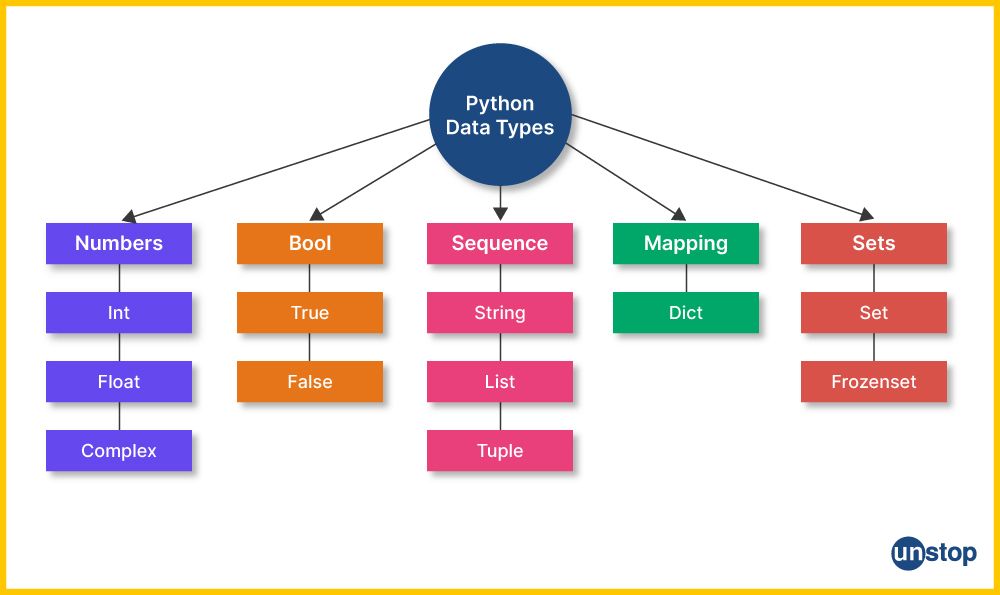
Python variables can hold many types of values/ data, from numeric values to arrays to even multi-dimensional arrays. It can even be a complex data structure like graphs, maps, binary trees, etc. Some common datatypes are:
1. Numeric Types:
- int: Represents integer values (e.g., 5, -10, 0).
- float: Represents floating-point numbers with decimal places (e.g., 3.14, -2.5, 0.0).
- complex: Represents complex numbers in the form of a + bj, where a and b are real numbers and j is the iota used to represent imaginary numbers (e.g., 2+3j).
2. Sequence Types:
- str: String represents a text or a word enclosed in single quotes ('') or double quotes ("") (e.g., "Unstop", 'variable', "text").
- list: Represents an ordered collection of items enclosed in square brackets ([]), where each item can be of any datatype (e.g., [1, 2, 3], ['a', 'b', 'c'], [1, 'two', 3.0]).
- tuple: Similar to lists but immutable, meaning their elements cannot be modified once defined. They are enclosed in parentheses (()) (e.g., (1, 2, 3), ('a', 'b', 'c'), (1, 'two', 3.0)).
4. Mapping Type:
- dict: Represents an unordered collection of key-value pairs enclosed in curly braces ({}). You can access any value if you have the other one. Keys are unique and used to access values (e.g., {'name': 'John', 'age': 30}).
5. Set Types:
- Set: It represents an unordered collection of unique elements enclosed in curly braces ({}). Duplicates are automatically removed. Eg: set_variable = {1, 2, 3, "cherry", True}
- frozenset: Similar to sets but immutable. Once defined, its elements cannot be modified (e.g., frozenset({1, 2, 3}), frozenset({'a', 'b', 'c'})).
6. Boolean Type:
It represents the truth values, True or False. You can even use 0 and 1 in their places where 0 represents False, and 1 represents True. Eg: boolean_variable = True
7. None Type:
It represents the absence of a value or a null value. Eg: none_variable = None
Python Variable Scope
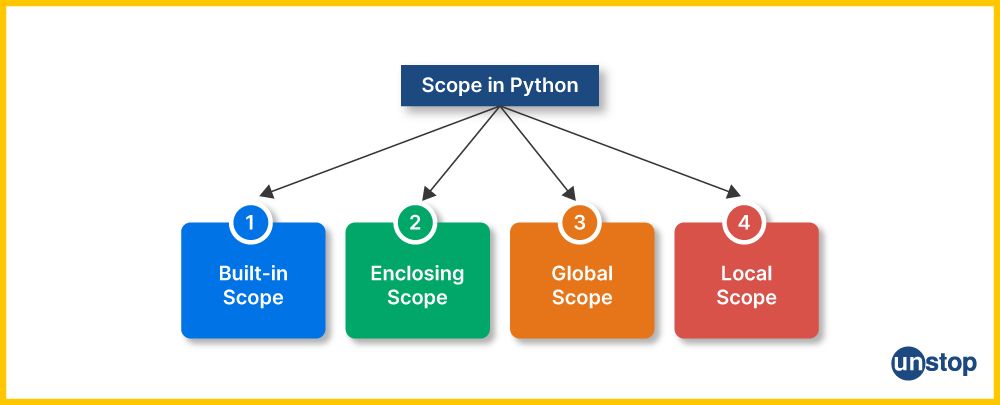
Python variable scope refers to a location inside the program where the respective variable is recognized, is accessible, can be modified, and can referenced within the code. For example, the variables in a function are temporary as we might need to call the function many times, even simultaneously in a loop, and storing these variable values globally can cause errors if the same function is running parallel.
Python variable scope can be customarily used for many specific applications while defining functions in your code. There are four types of variable scopes:
1. Local Python Variables
Variables defined within a function or class are of local scope and cannot be accessed outside of the function. Local variables are created when the function is called and are destroyed when the function completes execution. So, they are basically bound inside the function and have a life span till the function is running.
Each time a function is called, it creates a new instance of the variable. If the same function is running simultaneously, then also the local variable for both of them is stored in different memories as different occurrences.
Code Example:
CODE SNIPPET IS HEREIyBEZWZpbmUgYSBmdW5jdGlvbg0KZGVmIGZ1bmN0aW9uKCk6DQojIERlZmluZSBhIGxvY2FsIHZhcmlhYmxlIG5hbWVkIGxvY2FsX3ZhcmlhYmxlIHdpdGggYSB2YWx1ZSBvZiAxMA0KbG9jYWxfdmFyaWFibGUgPSAxMA0KDQojIFByaW50IHRoZSBsb2NhbCB2YXJpYWJsZQ0KcHJpbnQobG9jYWxfdmFyaWFibGUpDQoNCiMgQ2FsbCB0aGUgZnVuY3Rpb24NCmZ1bmN0aW9uKCk=
Output:
10
Explanation:
- We begin the example above by defining a function named function inside which we create a local variable named local_variable with a value of 10.
- Note that this variable is local to the function and exists only within the function's scope.
- Next, we use the print() statement within the function to output the value of the local variable.
- After that, we call the function(), which then prints the value of the local variable defined within its active scope. The local variable is not accessible outside the function.
- This variable is local as this would be deleted as soon as the compiler (the computer program that understands the code and provides output) exits the function.
2. Global Python Variables
Variables that are defined outside of any function or class have a global scope. This means they can be accessed from anywhere in the code, including within functions and classes. One must avoid using these in functions if not required. If you still need to, then it is best to store some constant values that do not hamper the operation of the function if run parallelly at the same time. You can also define a global variable within a function or class, but for this, you must use the global keyword before initialization.
Code Example:
CODE SNIPPET IS HEREIyBEZWZpbmUgYSBnbG9iYWwgdmFyaWFibGUgeCB3aXRoIGEgdmFsdWUgb2YgNQ0KeCA9IDUNCg0KIyBEZWZpbmUgYSBmdW5jdGlvbg0KZGVmIGZ1bmN0aW9uKCk6DQojIEFjY2VzcyB0aGUgZ2xvYmFsIHZhcmlhYmxlIHgNCnByaW50KHgpDQoNCiMgRGVmaW5lIGEgZ2xvYmFsIHZhcmlhYmxlIG5hbWVkIHZhcmlhYmxlIHdpdGggYSB2YWx1ZSBvZiAxMA0KZ2xvYmFsIHZhcmlhYmxlDQp2YXJpYWJsZSA9IDEwDQoNCiMgUHJpbnQgdGhlIGdsb2JhbCB2YXJpYWJsZSB2YXJpYWJsZQ0KcHJpbnQodmFyaWFibGUpDQoNCiMgQ2FsbCB0aGUgZnVuY3Rpb24NCmZ1bmN0aW9uKCk=
Output:
5
10
Explanation:
- We begin by defining a global variable x with a value of 5 outside any function, making it accessible throughout the entire script.
- Then, we define a function named function, which contains a print(x) statement that outputs the value of the global variable x. As is evident, we can access the global variable x from inside this function.
- We define another global variable named variable inside the function, with a value of 10 using the global keyword.
- Another print(variable) statement is included in the function, which outputs the value of the global variable variable.
- Lastly, we call the function(), and it prints the values of both global variables x and variable.
3. Nonlocal (Enclosing) Python Variables
Nonlocal variables in Python are variables declared within a nested function such that it does not belong to just that function but also to the enclosing function. It allows you to modify and access variables from the immediate outer scope within a nested function.
You might sometimes be required to make the Python variable accessible to just outside functions, for which you can create it outside and pass it as a parameter instead. However, nonlocal variables provide more flexibility and hence are preferred in some instances.
Code Example:
CODE SNIPPET IS HEREIyBEZWZpbmUgYW4gb3V0ZXIgZnVuY3Rpb24NCmRlZiBvdXRlcl9mdW5jdGlvbigpOg0KeCA9IDEwDQoNCiMgRGVmaW5lIGFuIGlubmVyIGZ1bmN0aW9uDQpkZWYgaW5uZXJfZnVuY3Rpb24oKToNCm5vbmxvY2FsIHgNCnggKz0gNQ0KcHJpbnQoIklubmVyIGZ1bmN0aW9uOiIsIHgpDQoNCiMgQ2FsbCB0aGUgaW5uZXIgZnVuY3Rpb24NCmlubmVyX2Z1bmN0aW9uKCkNCg0KIyBQcmludCB0aGUgdmFsdWUgb2YgeCBhZnRlciB0aGUgaW5uZXIgZnVuY3Rpb24gY2FsbA0KcHJpbnQoIk91dGVyIGZ1bmN0aW9uOiIsIHgpDQoNCiMgQ2FsbCB0aGUgb3V0ZXIgZnVuY3Rpb24NCm91dGVyX2Z1bmN0aW9uKCk=
Output:
Inner function: 15
Outer function: 15
Explanation:
- We first define an outer function named outer_function, where we initialize the variable x with the value 10.
- Inside this function, we define an inner function named inner_function, inside which-
- We define another variable, x, by using the nonlocal keyword to indicate that x refers to the variable defined in the outer scope (outer_function).
- Then, using the increment operator, we increase the value of x by 5 within inner_function.
- It also has a print() statement, i.e., print("Inner function:", x), which outputs the modified value of x within the inner function.
- Then, we call the inner_function from inside the outer function and also have a print() statement to display the value of x from the outer function.
- That is, print("Outer function:", x), which outputs the value of x within the outer function, demonstrating that the modification in the inner function affects the variable in the outer scope due to the use of the nonlocal keyword.
Note: Alternatively, if we did not use the nonlocal keyword inside the inner_function, and only redeclared x to the value of 5. Then, print("Inner function:', x) would output the value 5, and print("Outer function:", x) would output 10, indicating that changing x in the inner scope does not affect x in the outer scope.
4. Python Variables With Built-In Scope
The built-in scope of Python variables includes the ones in the namespace containing names that are preassigned in Python. These names are always available without the need for explicit imports. They include functions like print(), len(), data types (like int, str, etc.), and other commonly used elements. Here's a simple code example demonstrating the use of the built-in scope Python variables.
Code Example:
CODE SNIPPET IS HEREIyBVc2luZyBidWlsdC1pbiBmdW5jdGlvbnMNCnByaW50KCJIZWxsbywgV29ybGQhIikgIyBwcmludCBpcyBhIGJ1aWx0LWluIGZ1bmN0aW9uDQpsZW5ndGggPSBsZW4oIlB5dGhvbiIpICMgbGVuIGlzIGEgYnVpbHQtaW4gZnVuY3Rpb24NCnByaW50KCJMZW5ndGggb2YgJ1B5dGhvbic6IiwgbGVuZ3RoKQ0KDQojIFVzaW5nIGJ1aWx0LWluIGRhdGEgdHlwZXMNCmludGVnZXJfbnVtYmVyID0gaW50KCI0MiIpICMgaW50IGlzIGEgYnVpbHQtaW4gZGF0YSB0eXBlDQpmbG9hdGluZ19wb2ludF9udW1iZXIgPSBmbG9hdCgiMy4xNCIpICMgZmxvYXQgaXMgYSBidWlsdC1pbiBkYXRhIHR5cGUNCnN0cmluZ192YXJpYWJsZSA9IHN0cigxMjMpICMgc3RyIGlzIGEgYnVpbHQtaW4gZGF0YSB0eXBlDQoNCiMgVXNpbmcgb3RoZXIgYnVpbHQtaW4gZWxlbWVudHMNCmFic29sdXRlX3ZhbHVlID0gYWJzKC01KSAjIGFicyBpcyBhIGJ1aWx0LWluIGZ1bmN0aW9uDQptYXhpbXVtX3ZhbHVlID0gbWF4KDMsIDcsIDEsIDkpICMgbWF4IGlzIGEgYnVpbHQtaW4gZnVuY3Rpb24NCg0KIyBCdWlsdC1pbiBjb25zdGFudHMNCnBpX3ZhbHVlID0gcm91bmQoMy4xNDE1OTI2NTM1ODk3OTMsIDIpICMgcm91bmQgaXMgYSBidWlsdC1pbiBmdW5jdGlvbg0KcHJpbnQoIkFwcHJveGltYXRlIHZhbHVlIG9mIHBpOiIsIHBpX3ZhbHVlKQ0KDQojIEJ1aWx0LWluIHR5cGVzDQppbnRlZ2VyX3R5cGUgPSB0eXBlKDQyKSAjIHR5cGUgaXMgYSBidWlsdC1pbiBmdW5jdGlvbg0KZmxvYXRfdHlwZSA9IHR5cGUoMy4xNCkNCnN0cmluZ190eXBlID0gdHlwZSgiSGVsbG8iKQ0KDQojIEJ1aWx0LWluIHNlcXVlbmNlcw0KbGlzdF9leGFtcGxlID0gbGlzdCgoMSwgMiwgMykpICMgbGlzdCBpcyBhIGJ1aWx0LWluIHR5cGUNCnR1cGxlX2V4YW1wbGUgPSB0dXBsZShbNCwgNSwgNl0pICMgdHVwbGUgaXMgYSBidWlsdC1pbiB0eXBlDQoNCiMgQnVpbHQtaW4gbWFwcGluZw0KZGljdGlvbmFyeV9leGFtcGxlID0gZGljdCh6aXAoWydhJywgJ2InLCAnYyddLCBbNywgOCwgOV0pKSAjIGRpY3QgaXMgYSBidWlsdC1pbiB0eXBlDQoNCiMgQnVpbHQtaW4gaXRlcmF0aW9uLyBsb29wcw0KZm9yIGkgaW4gcmFuZ2UoNSk6ICMgcmFuZ2UgaXMgYSBidWlsdC1pbiBmdW5jdGlvbg0KcHJpbnQoaSkNCg0KIyBCdWlsdC1pbiBsb2dpY2FsIG9wZXJhdGlvbnMNCmFuZF9yZXN1bHQgPSBUcnVlIGFuZCBGYWxzZSAjIGFuZCBpcyBhIGJ1aWx0LWluIGxvZ2ljYWwgb3BlcmF0aW9uDQpvcl9yZXN1bHQgPSBUcnVlIG9yIEZhbHNlICMgb3IgaXMgYSBidWlsdC1pbiBsb2dpY2FsIG9wZXJhdGlvbg0Kbm90X3Jlc3VsdCA9IG5vdCBUcnVlICMgbm90IGlzIGEgYnVpbHQtaW4gbG9naWNhbCBvcGVyYXRpb24NCg0KIyBCdWlsdC1pbiBjb21wYXJpc29uDQplcXVhbF9yZXN1bHQgPSAoMiA9PSAyKSAjID09IGlzIGEgYnVpbHQtaW4gY29tcGFyaXNvbg0Kbm90X2VxdWFsX3Jlc3VsdCA9ICgzICE9IDQpICMgIT0gaXMgYSBidWlsdC1pbiBjb21wYXJpc29u
Output:
Hello, World!
Length of 'Python': 6
Approximate value of pi: 3.14
0
1
2
3
4
Explanation:
In this example, we demonstrate the use of various built-in functions, data types, and operations in Python.
- We first use the built-in functions print(), len(), int(), float(), and str() for different purposes, as mentioned in the code comments.
- Then, we use abs() and max() functions, where the former gives the absolute value of the parameter and later returns the max value from amongst its parameters.
- Next, we use the round() function, which rounds up the values passed as parameters, like the constant pi in this case.
- We also use the type() function, which determines the data types of variables passed as parameters.
- Then, we create sequences, i.e., lists and tuples, using built-in list() and tuple() functions, respectively.
- Next, we create a dictionary using the dict() and the zip() functions to combine two lists.
- We then employ the range() function to create a sequence of numbers for iteration inside a for-loop.
- After that, we use the built-in logical operators (and, or, not) and comparison/ relational operators (==, !=) to perform a comparison of input values/ integer objects.
- The code demonstrates the versatility of built-in functionalities without the need for explicit imports.
Concatenating Python Variables

Concatenation means combining two or more Python variables like strings or lists, etc. We generally use the addition arithmetic operator for this purpose. However, concatenation cannot be referred to as simple addition; that is, if we say we concat 4 and 5, we mean it would form 45, not 9.
We can use the same Python addition operator for both concatenation and addition operations, based on which datatype you use. But if you want to resolve any conflict that arises from using the addition arithmetic operator for concatenation, an alternative you can use is the inbuilt concat() function. It helps perform concatenation whenever required.
Code Example:
CODE SNIPPET IS HEREI2ludGlhbGl6ZSBhIHN0cmluZyBuYW1lZCBuYW1lDQpuYW1lID0gIkFzaGltYSINCg0KI2luaXRpYWxpemUgYW4gaW50ZWdlciB2YXJpYWJsZSBuYW1lZCBhZ2UNCmFnZSA9IDI1DQoNCiN3ZSB1c2UgdGhlIHN0cigpIGZ1bmN0aW9uIHRvIGNvbnZlcnQgYWdlKGludGVnZXIpIHRvIHN0cmluZyBhbmQgdGhlbiBjb25jYXRlbmF0ZQ0KcmVzdWx0ID0gbmFtZSArICIgaXMgIiArIHN0cihhZ2UpICsgIiB5ZWFycyBvbGQuIg0KDQpwcmludChyZXN1bHQp
Output:
Ashima is 25 years old.
Explanation:
- We begin by initializing a string variable name with the value Ashima and then an integer variable age with the value 25.
- Next, use the str() function to convert the integer age to a string so that it can be concatenated with the rest of the string variables.
- This is used inside the concatenation method, where we use the addition operator to connect the initial variables with string terms- is and years old, with spaces in the right places.
- The outcome of this concatenation operation on variables is stored in the variable result.
- Then, we use the print(result) statement to display the final string to the console, as shown above.
As an alternative to the str() method, you can also use the f-strings, which allow us to directly insert variables into the string using curly braces {}. In this method, the variables are automatically converted to strings and concatenated with the rest of the variables/ parameters.
Code Example:
CODE SNIPPET IS HEREI0NyZWF0aW5nIHR3byB2YXJpYWJsZXMgb2Ygc3RyaW5nIGFuZCBpbnRlZ2VyIHR5cGVzDQpuYW1lID0gIlJhaHVsIg0KYWdlID0gMjgNCg0KI1VzaW5nIGYtc3RyaW5nIG1ldGhvZCB3aGVyZSB3ZSBpbnNlcnQgYWdlIGluc2lkZSBjdXJseSBicmFjZXMgc28gdGhhdCB0aGVpciB2YWx1ZSBpcyB0cmVhdGVkIGFzIGEgc3RyaW5nDQpyZXN1bHQgPSBmIntuYW1lfSBpcyB7YWdlfSB5ZWFycyBvbGQuIg0KDQpwcmludChyZXN1bHQp
Output:
Rahul is 28 years old.
Explanation:
- We begin this Python example by creating a variable name to store the string value Rahul and a variable age to store an integer number 25.
- Next, we create a new variable result, which is assigned a value using the f-strings.
- Inside this f-string, we insert the names of Python variables we want to concatenate into the string within curly brackets.
- The outcome will be a concatenated string with the variables, name, age, and other terms.
- We then use the print() function to display the whole sentence to the output console.
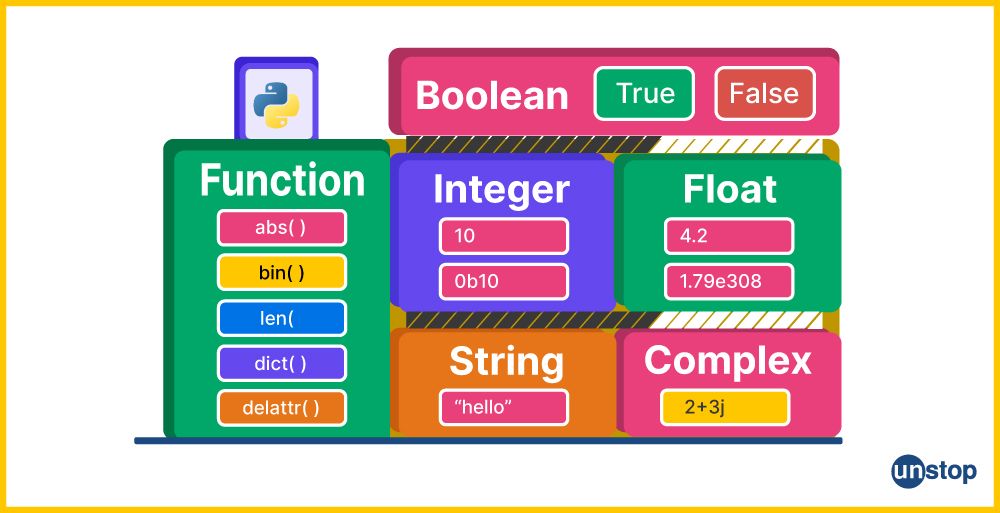
Check this out- Boosting Career Opportunities For Engineers Through E-School Competitions
Object Identity & Object References Of Python Variables
In Python, every piece of data is treated as an object. Objects have a unique identity, a value, and a type. When you create a variable and assign it a value, you are essentially creating a reference to an object. Understanding object identity and references is crucial for grasping how Python variables work.
Object Identity
In Python, every object has a unique identity, which serves as a way to distinguish it from other objects. The object identity is represented by a unique integer, and it remains constant throughout the object's lifetime. The id() function is used to obtain the identity of an object.
Example:
x = 42
print(id(x))
In this example, x is assigned the integer value 42, and id(x) returns the memory address of the object representing the integer 42.
Object References
An object reference is the association between a variable and the memory location (object) where the value is stored. When you create a variable and assign it a value, the variable is essentially a reference to the object in memory. Note that multiple variables can refer to the same object.
Example:
x = [1, 2, 3] # Creates a list and assigns it to variable 'x'
y = x # Creates a new reference 'y' pointing to the same list object
print(x)
print(y)
Here, both x and y reference the same list object in memory. Any modification made to the list through either x or y will affect the same underlying object.
Reserved Words/ Keywords & Python Variable Names
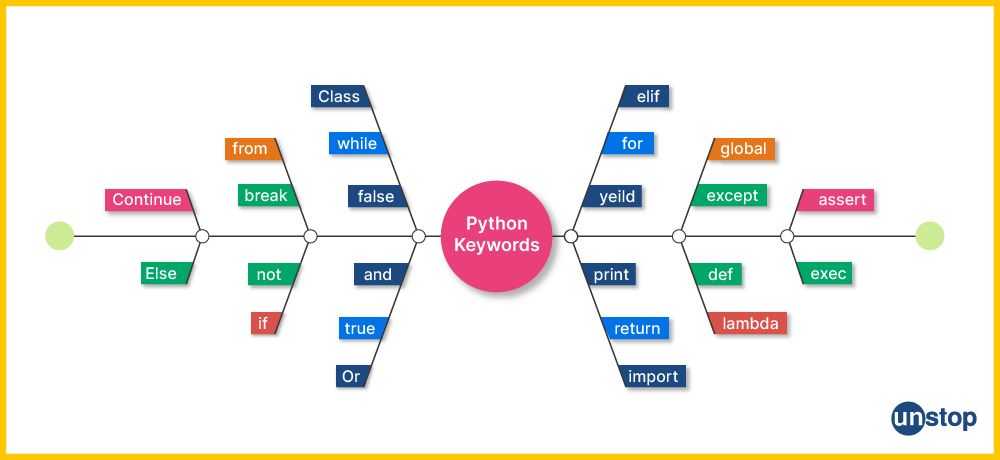
In Python, reserved words, also known as keywords, are specific words that have predefined meanings within the language. These words are reserved for specific purposes and cannot be used as identifiers (such as variable names or function names) in your code. Using these reserved words as variable names would lead to syntax errors and confusion. You can check these keywords anytime by simply typing help(“keywords”) on your Python interpreter, which is basically your terminal when you are coding in a Python ide. The table below gives a brief overview of some common Python keywords.
Table Of Python Keywords:
|
False |
None |
True |
and |
as |
assert |
async |
|
await |
break |
class |
continue |
def |
del |
elif |
|
else |
except |
finally |
for |
from |
global |
if |
|
import |
in |
is |
lambda |
nonlocal |
not |
or |
|
pass |
raise |
return |
try |
while |
with |
yield |
These keywords are case-sensitive. If you assign the variable name as these keywords, then it will throw syntax errors. Below is an example of the same.
Code Example:
CODE SNIPPET IS HEREI0NyZWF0aW5nIGEgdmFyaWFibGUgbmFtZXMgRmFsc2UNCiNCdXQgRmFsc2UgaXMgYSByZXNlcnZlZCB3b3JkIHVzZWQgZm9yIGJvb2xlYW4gcmVzdWx0cw0KRmFsc2U9NA0KDQojVHJ5aW5nIHRvIHByaW50IHRoZSBGYWxzZSB2YXJpYWJsZQ0KI1RoaXMgd2lsbCB0aHJvdyBhbiBlcnJvcg0KcHJpbnQoRmFsc2Up
Output:
False=4
^^^^^
SyntaxError: cannot assign to False
Explanation:
In the code above-
- We first create a variable called False and assign the value of 4 to it. Note that False is a reserved keyword used as a return value for boolean operations.
- Then, we use the print() method to display the value of this variable to the console.
- When we do this, we simply get a syntax error stating that the value cannot be assigned to False as it is a reserved keyword.
Conclusion
Understanding Python variables is foundational to writing effective and efficient code. Whether you are a beginner or an experienced developer, grasping the nuances of variables in Python is crucial for creating robust and maintainable programs. By following best practices and embracing the dynamic nature of Python variables, you can write code that is not only functional but also elegant and easy to comprehend. So, go ahead, experiment with variables, and unlock the full potential of Python programming!
Frequently Asked Questions
Q. What is a variable in Python?
A variable in Python is a symbolic name that references a value or an integer object/ string object. It provides a way to store and manipulate data in a program. Python variables are created using an assignment single statement, and their values can be changed during the execution of the program.
Q. Can we use the same name for different types of Python variables?
Yes, in Python, you can use the same name for variables of different types. Unlike some statically typed languages, Python is dynamically typed, which means you don't have to declare the type of a variable explicitly. The variable's type is determined at runtime based on the value it is assigned.
Here's an example:
CODE SNIPPET IS HEREIyBFeGFtcGxlIDENCnggPSA0MiAjIHggaXMgYW4gaW50ZWdlcg0KcHJpbnQoeCkNCg0KIyBFeGFtcGxlIDINCnggPSAiSGVsbG8sIFdvcmxkISIgIyB4IGlzIG5vdyBhIHN0cmluZw0KcHJpbnQoeCkNCg0KIyBFeGFtcGxlIDMNCnggPSBbMSwgMiwgM10gIyB4IGlzIG5vdyBhIGxpc3QNCnByaW50KHgp
In this example, the variable x is used for three different types. i.e., first as an integer, then as a string, and finally as a list. Python allows this flexibility, making it easy to work with different types of data using the same variable name.
Q. How do variable types work in Python?
Python is dynamically typed, meaning you don't need to declare the type of a Python variable explicitly. The interpreter infers the type based on the assigned value. Also these Python variables can hold different types, and their types can change during runtime.
Q. What is the scope of a variable in Python?
The concept of scope in Python variables refers to the region of the program from where a variable can be accessed. The different Python variable scopes include local, enclosing, global, and built-in Python. Understanding variable scope is crucial for writing maintainable and bug-free code.
Q. Can variables be used in string manipulation in Python?
Yes, variables can be used in string manipulation in Python. You can embed Python variables in strings using various methods like string concatenation, string formatting with % or format(), and f-strings. This allows for dynamic and flexible construction of strings based on Python variable values.
Q. What is the naming convention for Python variables?
The recommended naming convention for Python variables follows the guidelines outlined in PEP 8, the official style guide for Python code. Variables should use snake_case, where words are in lowercase and separated by underscores, promoting readability and consistency. Descriptive and clear names are encouraged to convey the purpose of the variable, avoiding single-letter names unless used as loop counters. It's crucial to avoid using Python-reserved words as variable names and maintain consistency in naming throughout the codebase. Ambiguous abbreviations should be avoided in favor of more explicit and understandable names.
Q. How are variables different from constants in Python?
Python variables are symbols that represent values and can change during program execution, while constants are values that do not change during program execution. In Python, there is no strict concept of constants, but conventionally, Python variables with uppercase names are considered constants and are not intended to be modified.
Rehash Python Variables Basics With A Quiz!
Here are a few more interesting topics you must read:
An economics graduate with a passion for storytelling, I thrive on crafting content that blends creativity with technical insight. At Unstop, I create in-depth, SEO-driven content that simplifies complex tech topics and covers a wide array of subjects, all designed to inform, engage, and inspire our readers. My goal is to empower others to truly #BeUnstoppable through content that resonates. When I’m not writing, you’ll find me immersed in art, food, or lost in a good book—constantly drawing inspiration from the world around me.
Login to continue reading
And access exclusive content, personalized recommendations, and career-boosting opportunities.
Subscribe
to our newsletter















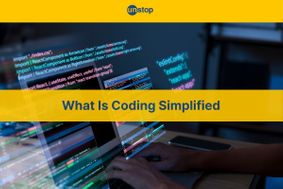
Comments
Add comment